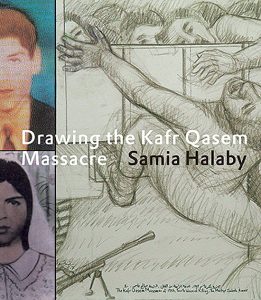By: Samia Halaby
Shilt Publishing, November 2016| Hardcover, 264 pages with 100 full-color illustrations
…………………………………………………………………..
Reviewed by: Inass Yassin
 Renowned artist Samia Halaby will present her newly published book, Drawing the Kafr Qasem Massacre, at the opening of her upcoming exhibition, “Documentary Drawings of the Kafr Qasem Massacre,” at Birzeit University Museum on February 22. The book features Halaby’s drawings which document the Kafr Qasem massacre that occurred in 1956. Their uniqueness lies in the specificity of the documentation regarding both individuals and events. The drawings are accompanied by the artist’s description of the research process and the difficulties involved in making these drawings.
Renowned artist Samia Halaby will present her newly published book, Drawing the Kafr Qasem Massacre, at the opening of her upcoming exhibition, “Documentary Drawings of the Kafr Qasem Massacre,” at Birzeit University Museum on February 22. The book features Halaby’s drawings which document the Kafr Qasem massacre that occurred in 1956. Their uniqueness lies in the specificity of the documentation regarding both individuals and events. The drawings are accompanied by the artist’s description of the research process and the difficulties involved in making these drawings.
Samia Halaby created her set of documentary drawings based on interviews with survivors. The emotions of anger and fear leap from every page of this book and enable the reader to bear witness to the terrible suffering endured by the inhabitants of this small Palestinian village. The artist relates: “I began drawing in an illusionist way, in the tradition of Renaissance art; but as the project progressed, I frequently questioned whether I perhaps should use an expressionist method instead. I admire Diego Rivera and thought that working in his manner, which influenced many of the Palestinian artists of the Intifada, might be a more modern path. However, after much thought, I decided that the expressionist and semi-cubist style of Rivera did not suit my ambition of presenting people as specific individuals in documented events.”
Palestinian author and lawyer Raja Shehadeh introduces Halaby’s work and reflects on her long artistic career and history of political commitment. Historian Dr. Salman Abu Sitta describes the historical context surrounding the events of the 1948 tragedy. In her introduction, Halaby presents how she conducted research among the few sources of information that she was able to find. “Along with my interviews, I conducted extensive research on historical materials and found a gold mine in the locally published magazine Al-Shorok, each October issue of which is dedicated to a commemoration of the massacre.”
The main part of the book introduces the series of drawings and the context as to when they were created. Then, drawings and narrative are divided based on the work of Emile Habibi, the Palestinian writer and journalist who first undertook the task of describing the entire massacre during the years 1956–1967. Finally, the book highlights the purpose of preserving such documentation for future historical study in a variety of disciplines.

